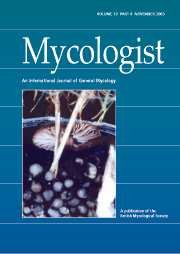Crossref Citations
This article has been cited by the following publications. This list is generated based on data provided by
Crossref.
Ainsworth, Martyn
2004.
Searching for luminous mushrooms of the Marsh Fungus Armillaria ectypa.
Field Mycology,
Vol. 5,
Issue. 4,
p.
142.
Desjardin, Dennis E.
Capelari, Marina
and
Stevani, Cassius
2007.
BioluminescentMycenaspecies from São Paulo, Brazil.
Mycologia,
Vol. 99,
Issue. 2,
p.
317.
Desjardin, Dennis E.
Oliveira, Anderson G.
and
Stevani, Cassius V.
2008.
Fungi bioluminescence revisited.
Photochemical & Photobiological Sciences,
Vol. 7,
Issue. 2,
p.
170.
BAUMGARTNER, KENDRA
COETZEE, MARTIN P. A.
and
HOFFMEISTER, DIRK
2011.
Secrets of the subterranean pathosystem of Armillaria.
Molecular Plant Pathology,
Vol. 12,
Issue. 6,
p.
515.
Alves, Eliana
Costa, Liliana
Cunha, Ângela
Faustino, Maria Amparo F.
Neves, Maria Graça P. M. S.
and
Almeida, Adelaide
2011.
Bioluminescence and its application in the monitoring of antimicrobial photodynamic therapy.
Applied Microbiology and Biotechnology,
Vol. 92,
Issue. 6,
p.
1115.
Napp, J.
and
Alves, F.
2014.
Comprehensive Biomedical Physics.
p.
1.
Weinstein, Philip
Delean, Steven
Wood, Tom
and
Austin, Andrew D.
2016.
Bioluminescence in the ghost fungus Omphalotus nidiformis does not attract potential spore dispersing insects.
IMA Fungus,
Vol. 7,
Issue. 2,
p.
229.
Magyar, Donát
Vass, Máté
and
Li, De-Wei
2016.
Biology of Microfungi.
p.
315.
Verdes, Aida
and
Gruber, David F.
2017.
Glowing Worms: Biological, Chemical, and Functional Diversity of Bioluminescent Annelids.
Integrative and Comparative Biology,
Vol. 57,
Issue. 1,
p.
18.
Ivarsson, Magnus
Skogby, Henrik
Phichaikamjornwut, Bongkot
Bengtson, Stefan
Siljeström, Sandra
Ounchanum, Prayote
Boonsoong, Apichet
Kruachanta, Mingkhwan
Marone, Federica
Belivanova, Veneta
Holmström, Sara
and
Marnocha, Cassandra
2018.
Intricate tunnels in garnets from soils and river sediments in Thailand – Possible endolithic microborings.
PLOS ONE,
Vol. 13,
Issue. 8,
p.
e0200351.
Cazabonne, Jonathan
2021.
The use of human senses in the identification of mushrooms.
Field Mycology,
Vol. 22,
Issue. 4,
p.
117.
Galipot, Pierre
Damerval, Catherine
and
Jabbour, Florian
2021.
The seven ways eukaryotes produce repeated colour motifs on external tissues.
Biological Reviews,
Vol. 96,
Issue. 4,
p.
1676.
Bhatt, Ankita
Singh, Neha
and
Arya, Arun
2022.
Biology, Cultivation and Applications of Mushrooms.
p.
547.
Olayta, Carlo Oliver M.
and
dela Cruz, Thomas Edison E.
2023.
Mycology in the Tropics.
p.
137.




